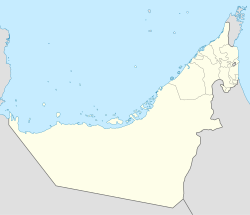
Dhaid, or Al Dhaid, is the capital of the Central Region of the Emirate of Sharjah in the United Arab Emirates. An oasis town, it has extensive irrigated date palm plantations with water channelled from the nearby Hajar mountains, at least in part through ancient tunnels dug for that purpose, known as aflāj in Arabic.
Sheikh Sultan bin Saqr Al Qasimi (1781–1866) was the Sheikh of the Qawasim and ruled the towns of Sharjah, Ras Al Khaimah, Jazirah Al Hamra and Rams; all within the then Trucial States and now part of the United Arab Emirates. Briefly a dependent of the first Saudi Kingdom, his rule over Ras Al Khaimah ran from 1803–1809, when he was deposed by order of the Saudi Amir and restored in 1820, going on to rule until his death in 1866 at the age of 85. He was Ruler of Sharjah from 1814–1866, with a brief disruption to that rule in 1840 by his elder son Saqr. He was a signatory to various treaties with the British, starting with the General Maritime Treaty of 1820 and culminating in the Perpetual Maritime Truce of 1853.
Sheikh Khalid bin Mohammed Al Qasimi was an Emirati royal, politician, and a founder of the United Arab Emirates who served as the ruler of the Emirate of Sharjah, from 1965 until his assassination in 1972.
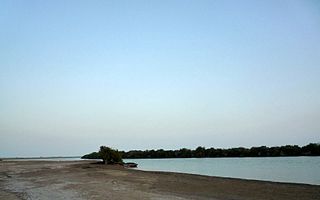
Kalba is a city in the Emirate of Sharjah in the United Arab Emirates (UAE). It is an exclave of Sharjah lying on the Gulf of Oman coast north of Oman. Khor Kalba, an important nature reserve and mangrove swamp, is located south of the town by the Omani border.

Sheikh Saqr bin Mohammed Al Qasimi was the Ruler of the Emirate of Ras Al Khaimah from 1948 to 2010. On 10 February 1972, under his leadership, Ras Al Khaimah become the seventh Trucial State to join the United Arab Emirates.

The Al Qasimi is an Arab dynasty in the Persian Gulf that rules Sharjah and Ras Al Khaimah, today forming two of the seven emirates of the United Arab Emirates. They are one of the longest reigning royal families in the Arabian peninsula. Historically, they also ruled over the town of Lengeh as sheikhs for a century until its annexation by Iran in 1887.
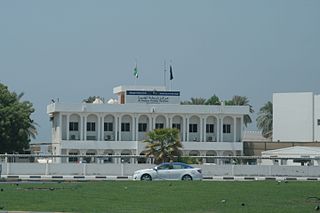
Al Heera is a suburb in Northern Sharjah in the United Arab Emirates, traditionally home to the Al Bu Shamis section of the Na'im tribe. At one stage declaring its independence from Sharjah, with its own Sheikh, it formally became part of the Emirate of Sharjah in 1942 on the death of its Ruler, Abdulrahman Al Shamsi. A coastal settlement with a small harbour formerly used by a number of fishermen and pleasure boat owners, its main distinguishing feature today is its police station, converted in 2019 into the 'Al Heera Literature Society' building.
Saqr III bin Sultan Al Qasimi was the ruler of the Emirate of Sharjah, a Trucial State and now one of the United Arab Emirates, from May 1951 to 24 June 1965.
Sheikh Saqr bin Khalid Al Qasimi (1883–1914) was the Ruler of Sharjah, a Trucial State and now one of the United Arab Emirates, from 1883–1914. He took control over Sharjah in a coup during the absence of his uncle, Salim bin Sultan Al Qasimi, and ruled both Sharjah and, from 1900 until his death in 1914, Ras Al Khaimah.
Sheikh Khalid bin Sultan Al Qasimi was Ruler of Sharjah, a Trucial State and now one of the United Arab Emirates, from 1866 to 1868 and of Ras Al Khaimah from 1866 to 1867. His short rule was most notable for the means of his accession, which involved the murder of his nephew, and also his death, at the hands of Abu Dhabi Sheikh Zayed bin Khalifa Al Nahyan in single combat.
Sheikh Khalid bin Ahmad Al Qasimi was the Ruler of Sharjah, a Trucial State and now one of the United Arab Emirates, from 1914–1924 and Ras Al Khaimah from 1914–1921. He acceded on the death of Saqr bin Khalid Al Qasimi. His rule was tumultuous and unpopular, marked by internecine conflicts and public discontent and saw the final disintegration of the Al Qasimi's joint rule over Sharjah and Ras Al Khaimah. Deposed as Ruler of Sharjah in 1924, he went on to become ruler of Dhaid and Kalba and a highly influential figure in the Shamaliyah.

Sheikh Sultan II bin Saqr Al Qasimi was the Ruler of Sharjah, a Trucial State and now one of the United Arab Emirates, from 1924 to 1951. His father having ceded the rule of Sharjah to Khalid bin Ahmad Al Qasimi, Sultan found himself dispossessed and married the daughter of Abdulrahman bin Shamsi, the headman of Al Heera. Buoyed by Khalid's unpopularity and Abdulrahman's force of personality and arms, Sultan deposed Khalid and became Ruler of Sharjah. However, he found the interior of the country dominated by Bedouin tribes and the East coast increasingly dominated by the former Ruler, Khalid bin Ahmad, leaving Sultan the effective ruler of a cluster of coastal settlements, many of which constantly tried to secede from his rule. He is cited as having presided over a low ebb in the power of the Al Qasimi, formerly a powerful maritime federation.
Sheikh Sultan bin Salim Al Qasimi was Ruler of Ras Al Khaimah from 1921–1948. His long and turbulent rule was characterised by internecine family and tribal disputes and he was finally removed as Ruler in a 1948 coup.
Humaid bin Abdulaziz Al Nuaimi was Ruler of Ajman, one of the Trucial States which today form the United Arab Emirates (UAE), from 1910–1928. His rule was marked by a running conflict with the Al Bu Shamis and their charismatic Sheikh, Abdulrahman bin Muhammad Al Shamsi.
Sheikh Hamad bin Abdullah Al Sharqi was the first recognised leader of the Al Sharqi Ruling family of Fujairah, one of the Trucial States and today one of the United Arab Emirates (UAE). He led Fujairah in a number of insurrections against Al Qasimi rule, presiding over a turbulent time when the emirate was practically independent but denied recognition of status as a Trucial State in its own right by the British.
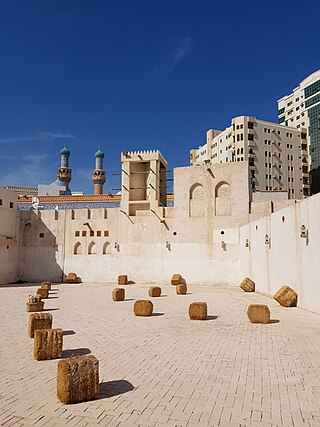
The Heart of Sharjah is a cultural heritage project that aims to preserve and restore the old town of Sharjah in the United Arab Emirates (UAE) and return it to its 1950s state.

Ajman Fort is a double-storey traditional rock, coral and mudbrick fortification in the centre of the city of Ajman in the United Arab Emirates (UAE). Its construction is thought to date back to the late 18th century and it is claimed the fort's barjeel, or wind tower, is the oldest such structure in the UAE.

Bithnah Fort is a traditional double story rock, coral and mudbrick fortification located in the Wadi Ham, near the village of Bithnah in Fujairah, United Arab Emirates. The fort has played a significant role in the history of the Emirates, particularly in the emergence of Fujairah as an independent emirate in the early 20th century. With a controlling position overlooking the Wadi Ham, the fort replaced an Iron Age fortification.
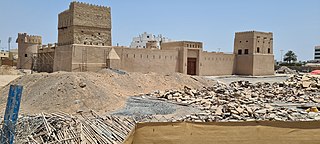
Dhaid Fort, is a restored C18th fortification in the city of Dhaid, Sharjah, in the United Arab Emirates. It has long been an important stronghold for the Ruling families of Sharjah and Ras Al Khaimah and a key strategic asset in maintaining a historical Qawasim dominance of the inland areas of the Northern Emirates.
Abdulrahman bin Muhammad Al Shamsi was the Sheikh, or head man, of the township of Al Heera, today a suburb of Sharjah in the United Arab Emirates. A highly influential and often divisive figure in regional politics during the early 20th century in the Trucial States, he was referred to by one British Political Resident as ‘a stormy petrel of the Trucial Coast, a man feared by everyone in and around Sharjah’.

